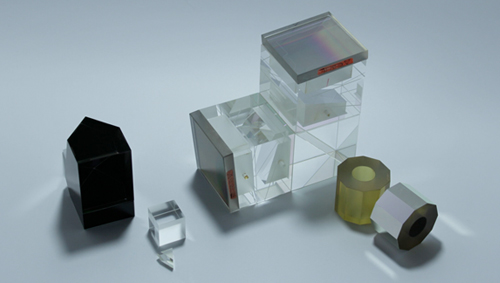 A prism can be described as a transparent object enclosed by two planes that intersect but are not parallel to each other, used to split or disperse light beams. Prisms are widely used for dual-channel instruments, anamorphic optical systems, and imaging systems. The parameter which is most important when specifying requirements is the prism angle tolerance.
A prism can be described as a transparent object enclosed by two planes that intersect but are not parallel to each other, used to split or disperse light beams. Prisms are widely used for dual-channel instruments, anamorphic optical systems, and imaging systems. The parameter which is most important when specifying requirements is the prism angle tolerance.
MLOPTIC PRISM PROCESSING CAPABILITY
|
Material |
Conventional Glass Materials (Schott, Ohara, Hoya, CDGM) Fused Silica |
|
Size |
Up to 150mm |
|
Angle tolerance |
±1 second |
|
Shape error |
Lambda/40 |
|
Face shape |
Lambda/20 |
|
Surface Quality |
10/5 |
|
Ultra -smooth finish |
<0.5nm |
|
Adhesive or optical glue bonding available |
|
RIGHT ANGLE PRISM
Right Angle Prisms can be used for beam deviation and retro-reflection. They are often preferable to plane mirrors, because they are easier to mount and align. High throughput is attained when the hypotenuse is used in total internal reflection (TIR), and the entrance and exit surfaces are anti-reflection coated.
HIGH PRECISION GLUED PRISMS
Bonding of MLOptic prisms is available, including optical glue and adhesive bonding. Prism assembly with a total of 10 prisms precision-glued can be provided, while maintaining the overall angle tolerance within 5 seconds. Precision right-angle prisms are made of high-grade materials and are mainly used in the laser field using glass and fused silica materials.
WEDGE
Wedges serve to deflect light and steer beams in optical systems such as range finders and variable focus assemblies. MLOptic can provide wedges in various sizes and angles according to customer requirements.
PENTA PRISM
The penta prism provides stable light deviation of 90 degrees regardless of angle of incidence. Standard penta prisms have applications in image erecting assemblies, and are used as laser insertion prisms for range-finding and advanced surveillance.
DOVE PRISM
Dove prisms are used to rotate the image plane so that the incoming and outgoing rays are parallel. A Dove prism is used to rotate, invert, or retroreflect an image, depending upon the prism's rotation angle and the surface through which the light enters the prism.
RHOMBUS PRISM
A rhomboid prism can shift light laterally without changing its direction of propagation. Rhombus prisms are widely used in instruments such as stereo microscopes and periscopes.
ROOF PRISM
The roof prism replaces one reflecting surface of the ordinary relay prism with a roof surface with a mutual angle of 90°. It is suitable for optical applications where both beam steering and erection are required.
PYRAMID PRISM
Pyramid prisms allow the reflected light for any angle of incidence to emerge parallel to the incident light. Pyramid prisms are often used for target determination and increased speed of alignment.
